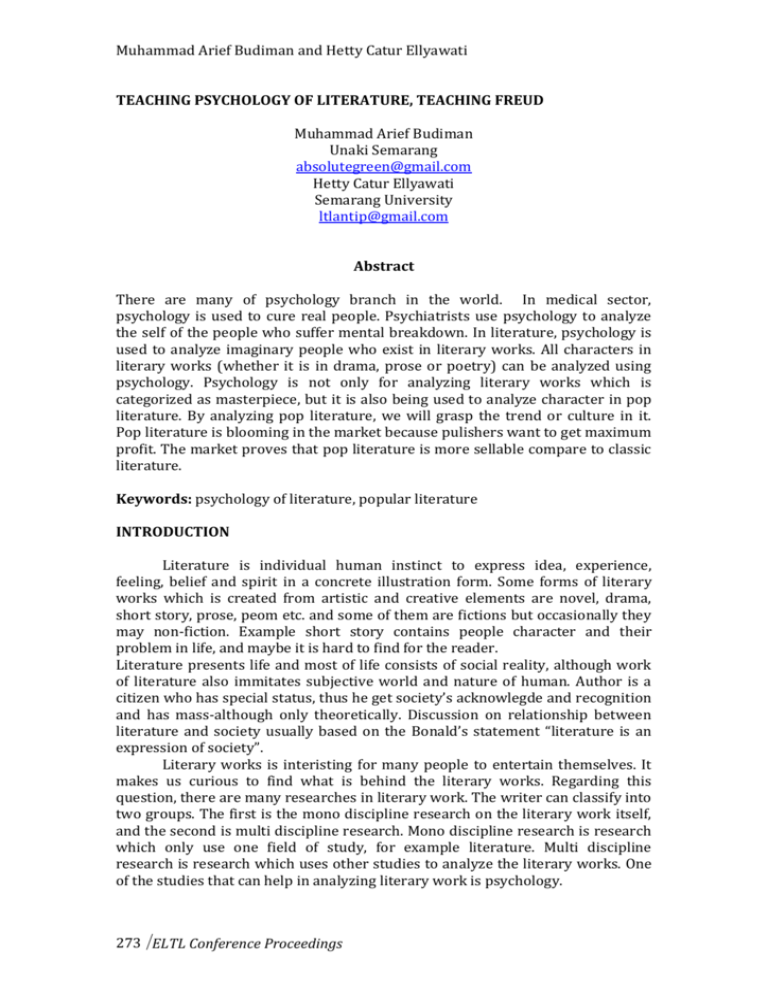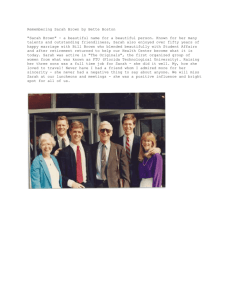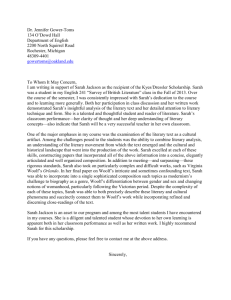TEACHING PSYCHOLOGY OF LITERATURE, TEACHING FREUD
advertisement

Muhammad Arief Budiman and Hetty Catur Ellyawati TEACHING PSYCHOLOGY OF LITERATURE, TEACHING FREUD Muhammad Arief Budiman Unaki Semarang absolutegreen@gmail.com Hetty Catur Ellyawati Semarang University ltlantip@gmail.com Abstract There are many of psychology branch in the world. In medical sector, psychology is used to cure real people. Psychiatrists use psychology to analyze the self of the people who suffer mental breakdown. In literature, psychology is used to analyze imaginary people who exist in literary works. All characters in literary works (whether it is in drama, prose or poetry) can be analyzed using psychology. Psychology is not only for analyzing literary works which is categorized as masterpiece, but it is also being used to analyze character in pop literature. By analyzing pop literature, we will grasp the trend or culture in it. Pop literature is blooming in the market because pulishers want to get maximum profit. The market proves that pop literature is more sellable compare to classic literature. Keywords: psychology of literature, popular literature INTRODUCTION Literature is individual human instinct to express idea, experience, feeling, belief and spirit in a concrete illustration form. Some forms of literary works which is created from artistic and creative elements are novel, drama, short story, prose, peom etc. and some of them are fictions but occasionally they may non-fiction. Example short story contains people character and their problem in life, and maybe it is hard to find for the reader. Literature presents life and most of life consists of social reality, although work of literature also immitates subjective world and nature of human. Author is a citizen who has special status, thus he get society’s acknowlegde and recognition and has mass-although only theoretically. Discussion on relationship between literature and society usually based on the Bonald’s statement “literature is an expression of society”. Literary works is interisting for many people to entertain themselves. It makes us curious to find what is behind the literary works. Regarding this question, there are many researches in literary work. The writer can classify into two groups. The first is the mono discipline research on the literary work itself, and the second is multi discipline research. Mono discipline research is research which only use one field of study, for example literature. Multi discipline research is research which uses other studies to analyze the literary works. One of the studies that can help in analyzing literary work is psychology. 273 ELTL Conference Proceedings Muhammad Arief Budiman and Hetty Catur Ellyawati RELATION BETWEEN LITERATURE AND PSYCHOLOGY Literature is one of the branches of art which has beauty aspect. Aesthetic aspect in literature can be seen in the language being used, the character being chosen, the problem being presented, the philosophy in the story etc. With its language, the writer wants to show the beauty aspect in his work. Beside aesthetic, there are other aspects in literary work such as: sociology, culture, anthropology, etc. One of the aspects in literature is psychology. Psychology is an academic and applied discipline that involves the scientific study of mental functions and behaviors. In literature, psychology can be seen from three angles, they are: psychology of the writer, psychology of the reader, and psychology of the literary work itself. “The critic may ignore any correspondence between the author’s life and his creation but adapt the psychoanalytic method to the study of the characters in the literary work itself, trating them as self-complete entities wholly within the context of the work.” (Greibstein, 1968: 239). If we want to analyze the psychology of the writer, we treat the literary work the same as the historical artifact. We should study the life history of the writer behind the literary work because literary work is reflection and projection of the writer. In psychology of the writer, we also study the creative process of the writer in creating a literary work. In psychology of the literary work, we can apply psychoanalysis to analyze the characters in the story. The researcher should treat the characters in the story as a complete entity in a world which is represent in the story. In psychology of the reader, the analysis can be focused on the influence of the literary work to the reader, analyze the personal experinece of the reader which is reflected in the story. The reader often feels that what is in the story is like his own life. This is because there is no single experience that one hundred percent unique. The work of art in general and literary work can expose realty through its characters in the story and through its techniques which is being used in creating those characters. Fictional characters in the story are almost the same as real people which have psysical appearances and psychological traits. Thus it is not wrong if we analyze those characters using psychology as the psychologist analyze his patient. Jacqueline Reiter’s Scapegoat can be categorized into popular story. A modern popular work of art can achieve certain position like myth in the past, which is the position of a myth as modern religion. In the modern industrial society nowadays most people have evolving thoughts. Some of the consider religion as law that limits their moves. They try to find another quidance which able to give freedom. Some of them find literature as their guidance in life. SYNOPSIS The two girls waited for the coast to clear. Sarah sat on the closed toilet seat and cuddled her stockinged knees to her chest. Through the dark hair that fell about her face she could see Kay propped againts the cubicle door, arms crossed and head slightly inclined. “What if we get caught? “We won’t,’ Kay replied. She nibbled the nail on her right index finger, a sure sign that she was deep in thought. “When the time comes just keep close. You’ll be fine. “Her school uniform was impeccable, her blonde hair pulled up into a neat ponytail. Kay was 274 ELTL Conference Proceedings Muhammad Arief Budiman and Hetty Catur Ellyawati always so self-possessed: she seemed to know everything, and always made even the riskiest of pranks appealing. Sarah, small, dark and slightly plump, had never been part of the popular crowd, so it was flattering when Kay asked her to be involved in her schemes. She had let Kay copy her homework, raided the store cupboard for her, even graffitied one of the school climbing frames in return for an approving smile. Disloyal as it seemed, Sarah couldn’t help having her doubts this time. Yes, assemblies were dull; and yes, it was true few teachers bothered to check that all their pupils came in and out of the great hall. Sarah wriggled her toes in her scuffed black shoes and stared up the cracks in the white ceiling. School bathrooms were always the same: bleak and characterless, they reeked of disinfectant and cheap toilet paper. “Maybe this isn’t such a good idea…” “I think it’s time. Are you ready?” “Yes, Sarah lied. “Then follow me. Remember: keep close.” They slipped out of the bathroom into the broad, high-ceilinged corridor. Kay moved with sinuous grace; her rubber-soled shoes hardly made a sound. Sarah left clumsy in comparison, but followed as surreptitiously as she could manage. “What are you doing?” Mrs. Davis repeated, her fury echoing in every long vowel of her Welsh accent. The relief flooded Sarah’s body. Of course: how could see have been so stupid? She had forgotten that she and Kay were in this together. Kay had such a wonderful way with words. She could explain away anything. Surely once she had apologised to Mrs Davis everything would be all right. They would not get away without punishment, but with any luck coming clean would ensure it would be mild. Sarah lost sight of Kay at the corner of the corridor as Mrs Davis marched her to the headmistress’s office, like a tall greyhaired prison guard. Kay still stood with her hands gripped together in her skirts, the expression of the terrified pity firmly soldered to her face, playing her part to the last. FREUD’S PSYCHOANALYSIS In analyzing Jacqueline Reiter’s Scapegoat, the writer uses Freud’s psychoanalysis. If the research of the literary work only focuses on the autonomy of the work itself, there will be many weaknesses. This is because literary work cannot be separated from the supporting elements which shape the work. Thus here the writer also uses another discipline to analyze Jacqueline Reiter’s Scapegoat. The other discipline is psychology as psychology aspect also exists in the literary work. Here the writer uses Freud’s psychoanalysis. In Freud’s psychoanalysis, the personality structure is divided into three; id, ego, and superego. “The most well known of Freud accounts of the structure and operation of the mind is the model of the id, the ego, and the superego.” (Green: 1996: 148). In Freud’s psychoanalysis, unconsiousness is divided into three: id, ego, and superego. Those three parts are connected each other and connot be separated. Beside personality structure, Freud also discussed ego defense mechanism. Beside using personality structure, for analysing Jacqueline Reiter’s Scapegoat the writer also uses Freud’s ego defense mechanisms. Ego defense mechanisms are extreme methods to erase pressure which sometimes must be performed by ego. There are nine ego defense mechanisms mentioned by Freud. They are repression, projection, reaction forming fixation, regression, introjections, displacement, sublimation, and rationalization. Those nine 275 ELTL Conference Proceedings Muhammad Arief Budiman and Hetty Catur Ellyawati mechanisms have different techniques in facing the pressure. Between one mechanism and the other is not the same. All human’s behaviors can be classified into two groups: prosper behaviors and malign behaviors. Those two behaviors are motivated by two instincts which are contrast to each other (libido and destrudo). Libido is the energy which makes people behaves to benefit themselves. Libido is the combination of death and born instinct. (Cahplin, 2004: 32). “Libido is a quantitatively variable force related to sexual excitation. The totality of mental energy at the disposal or eros, the instinct of live.” (William, 1973: 42). Destrudo is destroying energy. Most people do not realize that what they do is ruining themselves. Self destroying is always be seen from other’s point of view. Destrudo is energy which relate to death. (Chaplin, 2004: 14). “Destrudo is the emotional energy of ares, a primitive, archaic, destructive energy which is normally fused with libido. When libido fails in a state of regression, the destructive energy takes over.” (Wolman, 1973: 24). From the analysis which has been done, the writer finds that most of human’s behaviors is based on the purpose for getting fun. This is in accordance with the concept of hedonism. Some of the people in this world live only for acquiring fun. They do not want to be burdened in their live. Hedonism is psychology term which says that individuals behave in certain way to always getting fun and avoiding sadness and painfulness. (Chaplin, 2004: 28). Beside motif for searching fun, there are other motivates which background all human’s behavior in this world. The writer uses theory pf motif to find supporting elements on behaviors which are done by the main character in Jacqueline Reiter’s Scapegoat. The word motif comes from Latin “movere” which becomes “motion” which means move or impulse to move. Every action done by a person is based on the impulse inside him. This impulse is called motif. “Motive is a state within an organism which energizes and directs him toward a particular goal.” (Wolman, 1973: 243). Motif in a person is base of all the actions he performs in this world. PERSONALITY STRUCTURE The most-well known of Freud’s accounts of the structure and operation of the mind is the model of the id, the ego, and the superego. The ID applies to the instinctual drives that relate to the needs of the body, the id is primitive and needy, incapable of denying itself. Sarah’s wish is to be accepted by Kay. She will do everything in order to be liked by Kay. This is the basic of human need which implies that people cannot live alone. People need other human to live with. The EGO develops out of the id and it pacifies the drives, by offering itself as a substitude for what must be denied the id (a kind of psychic equivalent of a baby’s soother). Sarah asks to Kay what will happen if they caught on their conduct. Sarag realizes that what they do is wrong. But she cannot control herself to be associated with Kay. For Sarah, Kay is symbol of popularity. If she is accepted by Kay, she will have a wonderful school life. The SUPEREGO is representative of external, social influences upon the drives, and is formed in the image of the earliest identifications of the ego with the father. The contrast between two instinct mentioned above (instinct of afraid to be caught doing something wrong and instinct to be accepted socially) is in 276 ELTL Conference Proceedings Muhammad Arief Budiman and Hetty Catur Ellyawati Sarah’s mind. The id is against the ego. But Sarah’s ego wins the battle. Sarah does not care about the voice within her that tells her about her wrongdoing. What is important at the moment is that associated with Kay thus she can climb the ladder of popularity. EGO DEFENSE MECHANISM Ego defense mechanism is a tactic developed by the ego to protect against anxiety. Ego defense mechanisms are thought to safeguard the mind againts feelings and thoughts that are too difficult for conscious mind to cope with. In some instances, defense mechanisms are thought to keep inappropriate or unwanted thoughts and impulses from entering the conscious mind. For example, if you are faced with a particularly unpleasant task, your mind may choose to forget your responsibility in order to avoid the dreades assignment. In addition to forgetting, other defense mechanism include denial, rationalization, repression, projection, reaction formation, intellectualization, regression, displacement, sublimation. Repression is another well-known defense mechanism. Repression acts to keep information out of consious awareness. However, these memories don’t just dissapear; they continue to influence our behavior. For example, a person who has repressed memories of abuse suffered as a child may later have difficulty forming relationships. Sometimes we do this consciously by forcing the unwanted information out of our awereness, which is known as suppression. In most cases, however, this removal of anxiety-provoking memories from our awareness is believed to occur unconsciously. In the story Sarah represses this thought about her guilty feeling. She feels guilty to abandon the class. But she represses this thought and ignores the warning from the voice within her. She just wants to do what is right for the moment. Projection is taking your own unacceptable impulses and attributting them to someone else. The impulses are still judged unacceptable but they belong to someone else, not you. At that point you are free to criticize that person for not having such terrible impulses. The final result is that you no longer feel threatened and you can maintain your self-esteem by ignoring an objectionable aspect of yourself. Sarah’s projection can be seen when she admires Kay. She considers Kay as a perfect student. Kay is popular, while she is a nerd. She wants to change her own character to be the same with Kay’s. Reaction Formation is the defense which goes a step further than projection to the point of not even acknowledging unwanted impulses or thoughts and convincing yourself you are not one of “them” who do engage in those patterns. For instance, because a person totally rejects the idea of war, he may become a pacifist. Because he is afraid of war, he is changing his hatred of war into exactly the opposite-a love for peace. Freud called this “going overboard.” One example might be of a man who is secretly gay, but engages in many heterosexual affairs in an attempt to disguise his homosexuality. He feels his secret is safe, cloaked in his outgeous promiscuous behavior. 277 ELTL Conference Proceedings Muhammad Arief Budiman and Hetty Catur Ellyawati Sarah’s reaction formation can be seen when she is staring the ceiling of the bathroom. When her mind is full of strom, she tries to soothe herself by looking at the plain object surround her. She hopes the plainness of the object will make her mind calm. Fixation is when the personality development stops at early stage because the next stage is full of anxiety. A person unconsciously stops his development because he thinks that the next stage is full of difficult challenges which hard to solve. By stopping his development, he expects not to meet heavy challenges. Sarah’s fixation can be seen when she acts as if she is a child who cannot decide what is good for herself. When Kay asks her to follow every step she makes, Sarah does it willingly without hesitation. Sarah’s thought approves every decision Kay makes as if Kay is her mother and will give a very good decision for her life. Introjection is mechanism which is in contrast with projection. The other name of introjection is identification. Here the person insert into himself the aspects of the object and person outside himself. As an adult we often introject the aspect of our environment thus they become integral part of our life. Sarah’s introjection can be seen when she is very calm when the teacher catch her. She introjects Kay’s character into herself. She wants to be as tough as Kay in facing the problem. She does not want to be seen as a nerd and weak person. Regression is when people having traumatic experience and he goes back to the early stage of his life. When people go back to early stage, he expects to find comfort. He wants to avoid all the problem which appear in the next stage. Sarah’s regression can be seen when she is dependence toward Kay. Sarah does not say anything when the teacher catches her. She hopes Kay will give explanation that will save her. She puts all the sollution into Kay’s hand without thinking anything. Displacement is mechanism of directing the feeling from the source into the subtitution. Displacement has two main functions. The first to replace the depression feeling into other object. The second is to satisfy the feeling which cannot be expressed due to the circumtances. Sarah’s displacement is when she is stupified after hearing what Kay said. Kay blames her for what happen. And the teacher believes what Kay said. Thus Sarah feels extremely uncomfortable. She cannot express the storm in her mind. Thus she stay silent when the teacher drags her to headmaster’s office. CONCLUSION The motif of the main character (Sarah) in her wrongdoing is to get a certain position in the school. Implicitly the writer describes that Sarah is a nerd that does not belong to the popular group (Kay’s group). To beautify her school life, Sarah does what the other will do. She is willingly following Kay’s suggestion to skip the class in order to be considered as a cool person. She does not want to think that Kay bullies her as Kay is copying Sarah’s work. Sarah ignores the voice within her that tells her that what she does is wrong. By ignoring the voice, Sarah is running herself. For the sake of popularity, Sarah is willing to do everything although it will damage her school life. 278 ELTL Conference Proceedings Muhammad Arief Budiman and Hetty Catur Ellyawati References Abrams, M H. 1976. The Mirror and the Lamp: Romantic Theory and The Critical Tradition. Oxford: Oxford University Press. Barnet, Sylvian. Berman, Morton. Birto, William. 1989. An Introduction to Literature (Fiction, Poetry, Drama) Ninth Edition. Glenview, Illinois, Boston, London: Scott Foresman, and Company. Barnhart, Clarence H. Barnhart, Robert K. 1988. The World Book of Dictionary. Chicago: World Book Inc. Bertens, K. 1983. Sigmund Freud: Sekelumit Sejarah Psikoanalisa. Jakarta: Gramedia. Boeree, Dr C George. 2004. Personality Theories: Melacak Kepribadian Anda Bersama Psikolog Dunia. Ringinsari: Prisma Sophie. Brown, Wentworth K. Olmsted, Sterling P. 1962. Language and Literature. New York: Harcourt, Brace and World Inc. Djojosuroto, Kinayati. 2006. Analisis Teks Sastra dan Pengajarannya. Yogyakarta: Penerbit Pustaka. Freud, Sigmund. 2005. Psikopatologi dalam Kehidupan Sehari-hari. Pasuruan: Penerbit Pedati. Greibstein, Sheldon Norman (ed). 1998. Perspectives in Contemporary Criticism. New York: Harper and Row Publishers. Hall, Calvin S. 1995. Freud: Seks, Obsesi, Trauma, dan Katarsis. Jakarta: Delapratasa. Hardjono, Ratih. 1992. Suku Putihnya Asia: Perjalanan Australia Mencari Jati Dirinya. Jakarta: PT Gramedia Pustaka Utama. Harsono, Siswo. 1999. Metodologi Penelitian Sastra. Semarang: Yayasan Deaparamartha. Irwanto dkk. 1991. Pengantar Psikologi Umum. Jakarta Kennedy, X J. Literature-An Introduction to Fiction, Poetry, and Drama-Third Edition. Toronto: Little Brown, and Company (Canada) Limited. Keraf, Gorys. 1982. Argumentasi dan Narasi. Jakarta: PT Gramedia Pustaka Utama. Mappiane, Andi. 1983. Psikologi Orang Dewasa Bagi Penyesuaian dan Pendidikan. Surabaya: Usaha Nasional. 279 ELTL Conference Proceedings Muhammad Arief Budiman and Hetty Catur Ellyawati Martaniah, Sri Mulyani. 1984. Motif Sosial: Remaja Suku Jawa dan Keturunan Cina di Beberapa SMA Yogyakarta. Yogyakarta: Gajah Mada University Press. Meyer, Michael. 1990. The Bedford Introduction to Literature Second Edition. Boston: Bedford Books of St Martin’s Press. Mischael, Walter. 1981. Introduction to Personality Third Edition. USA: CBS College Publishing. Nurgiantoro, Burhan. 1994. Teori Pengkajian Fiksi. Yogyakarta: Gajahmada University Press. Pickeinr, James H. et all. 1989. Concise Companion to Literature. New York: Mac Millan Publishing Co Inc. Rifai, Melly Sri Sulastri. 1983. Psikologi Perkembangan Remaja: dari Segi Kehidupan Sosial. Bandung: PT Bina Aksara. Robert, Edgar N. 1973. Writing Theme About Literature. New York: Prentice Hall Inc. Semiun, Yustinus. 2006. Teori Kepribadian. Jakarta: Bumi Aksara. Tsiolkas, Christos. 1995. Loaded. Sydney: Vintage. Webster’s New Collegiate Dictionary. 1951. Webster’s New Collegiate Dictionary. London: G Bell & Sons Ltd Wolman, Benjamin B. 1973. Dictionary of Behavioral Science. New York: Van Nostrand Company. 280 ELTL Conference Proceedings




